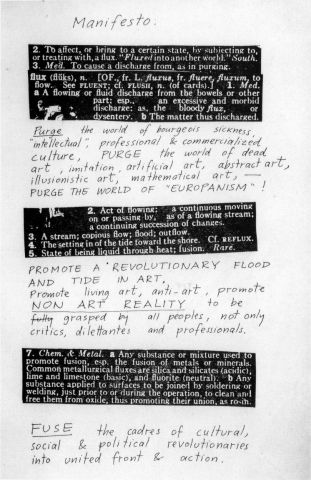My recent explorations of the connections between art and anthropology within the context of the museum have led me to begin producing wooden vitrines and cabinets to house my work. These cabinets take the form of shelving units or compartments which are designed in tandem with the objects to be displayed, as an element of the finished work. This seems to give the items, which are often paper-based, the illusion of longevity, often afforded by museums.
However, unlike traditional vitrines and museum cabinets, I am not just interested in preserving items collected from my practice, but in engaging the audience to interact with the objects, or to build new interactive elements directly into the cabinets. In this way, the work becomes an anthropological museum of art practice, as well as an ongoing relational experiment in which the audience are invited to become active participants.
The Flux Cabinet
Similar collections of artistic practice have been created previously, most notably by the Fluxus collective of the 1960 and 70s. James Trainor’s account of The Flux Cabinet in The Museum as Muse: Artists Reflect details the accumulated practice of the Fluxus group under the leadership of group founder George Maciunas.
“From its inception in 1962, [Maciunas understood] the critical importance of structure and organization in sustaining the movement’s collective identity and ensuring its continued existence. Between 1963 and 1978, Maciunas designed and executed numerous Fluxus anthologies, collections of works produced in editions and sold through a special mail-order system, intended to serve multiple functions: to give coherent order to the voluminous creative product of the individual artists associated with Fluxus; to propangandize the Fluxus name and the movement’s declared anti-formalist, anti-art ideals; and to establish a distribution system independent of the mainstream art market.” (Trainor, 1999, p83)
Methods of working
Maciunas’ deliberate use of the term ‘anthology’ to describe each collection, points to the idea that he saw the compiled works as visual texts, and although the works were “often randomly organised according to chance procedures”, the term conveys a sense of completeness and belonging to the work as a whole. (Trainor, 1999, 83)
Before producing the final Flux Cabinet, Maciunas produced various different versions of anthologies, according to his interests in functional architecture and furniture design:“The first anthology, Fluxus Year Box I (1963), was an edition of wood boxes containing musical scores, handbills of “Fluxevents”, conceptual pieces, diminutive objects, photographs, and pull-outs of various kinds… The Fluxkits (1964-65 to the late 1960s) represented an intermediate stage between the Year Boxes and the Fluxus Cabinet of 1975-77 [and] took the form of attache cases, with the contents varying widely from copy to copy.” (Trainor, 1999, 83).
Art and anthropology
Anthologizing the works in this way, not only gave the the Fluxus group agency over the way that their oeuvre would be seen by future generations, but it also seemed akin to a type of anthropological practice, where objects were displayed in the contexts of their use, maker and networks. This perhaps differs from more ‘traditional’ forms of anthropology, given that the collators of the work were the artists themselves, and the works were not ‘living’ objects, but were instead multiples produced for the purpose of display, or documents/scores relating to more ephemeral artworks and performances.
Of course the irony of creating an archive of tactile and participatory works is that as soon as it gains ‘Artworld’ value, the works included are no longer accessible in the ways for which they were designed. This begs the question, is it possible to create a ‘living’ anthropology of objects?
Further reading:
http://www.nomads.usp.br/pesquisas/cultura_digital/arte_em_processo/Processo/Textos/Fluxus%20Reader.pdf
http://www.deluxxe.com/beat/fluxusworkbook.pdf
Between Art and Anthropology: Contemporary Ethnographic Practice, Arnd Schneider and Christopher Wright (eds.), (Berg: Oxford and New York, 2010)
Contemporary Art and Anthropology, Arnd Schneider and Christopher Wright (eds.), (Berg: Oxford and New York, 2006)
Anthropology and Art Practice, Arnd Schneider and Christopher Wright (eds.), (Berg: London and New York, 2013)

